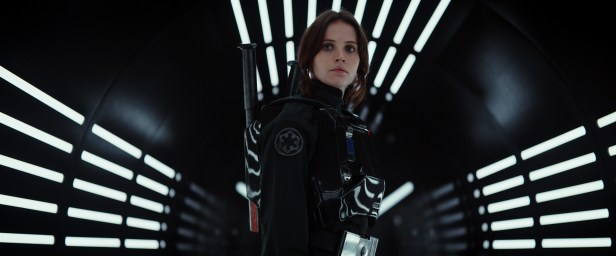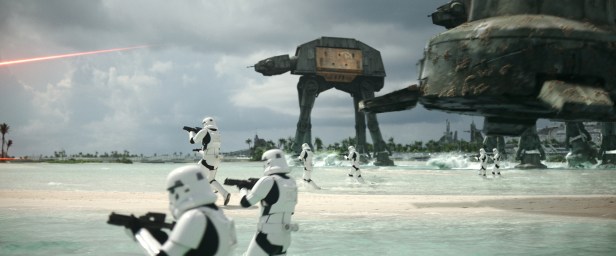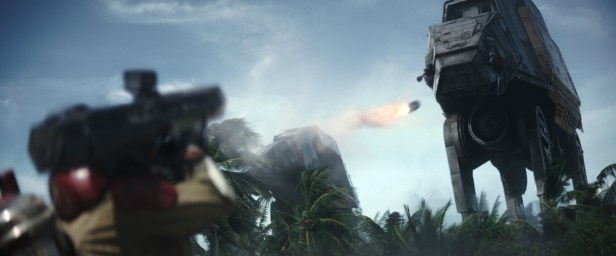Rogue One: A Star Wars Story (2016)
A rebellion built on hope.
The very first picture in a series of collective spin-off stories set ‘a long time ago in a galaxy far, far away,’ a universe created way back in 1977 by George Lucas, Rogue One: A Star Wars Story breaks new ground, the film venturing into somewhat uncharted space. With no episode number or opening crawl in sight (though still concluding with the classic Star Wars fanfare), Rogue One feels ‘liberated’ to take the sort of risks that most numbered chapters could not. With no beloved characters around either — bar the intimidating helmet-and-caped Darth Vader (voiced, once again, by the legendary James Earl Jones) — all bets are off, the movie taking a simple line from A New Hope’s credit crawl and expanding it into a fully fledged narrative; it’s a story we kinda already know (or at least know how it ends), but have never actually seen.

The first ‘standalone’ adventure in the ever-growing Star Wars canon — though feeling like a bit of an Episode III and a half — Rogue One takes place in the ‘unoccupied’ stretch of time between Episode III – Revenge of the Sith (2005) and Episode IV – A New Hope (1977) — a kind of ‘oppression’ period for the Galaxy — and hones in on a group of motley heroes who band together to fight the tyrannical Galactic Empire, whose rule of terror reigns supreme, setting off on a near-impossible task to steal the plans to the Empire’s superweapon known as the Death Star, a moon-sized warhead capable of wiping out entire planetary systems.
The story focuses on unlikely heroine Jyn Erso (Felicity Jones), a small-time crook and prisoner of the Empire who’s freed by Cassian Andor (Diego Luna) and his ragtag team of Rebels, including his unflappable companion, a re-wired Imperial bot who goes by the name K-2SO (voiced and motion-captured by Alan Tudyk). This rescue mission, however, lands Jyn in the care of the Rebel Alliance — currently operating out of Yavin IV — where she’s reluctantly recruited by the said, due to her connection with Saw Gerrera (Forest Whitaker), a man who fathered Jyn when she was separated from her own dad, Galen Erso (Mads Mikkelsen), at age six — Jyn’s father, Galen, an engineer-type scientist who helped the Empire create their new armored battle-station.
You see, Jyn’s connection with Saw could ultimately lead the Rebels to a former cargo pilot for the Empire named Bodhi Rook (Riz Ahmed). Currently being held captive by Saw, Bodhi holds a top-secret message from Galen, this hologram recording revealing that the weaponized moon was purposely designed with a defect in the form of a weak spot — I guess now we know why the Death Star went down so easily, huh! And before long, Jyn is inadvertently thrust into a dangerous mission to infiltrate the planet Scarif — a secluded, heavily fortified ‘tropical paradise’ housing an Empire stronghold — to swipe the schematics for the infamous ‘planet-killer.’

Helmed by franchise newcomer Gareth Edwards, Godzilla (2014), Rogue One is grittier, darker and more complicated than any other Star Wars film, the big bad, this time, being a frightful ideology as opposed to a striking villainous figure. With a screenplay by Chris Weitz, About a Boy (2002), and Tony Gilroy, The Bourne Ultimatum (2007) — developed from a story by Gary Whitta, The Book of Eli (2010) and visual effects maestro John Knoll — Rogue One essentially attempts to explain a plot hole that’s been the subject of ridicule for years now — and that is, why was the Death Star designed with such a sizable flaw? Be that as it may, the film succeeds thanks to its central theme of hope and the idea that battles are won by ‘teams,’ not singular individuals, the movie highlighting that even the smallest of acts can make a huge difference.
Punctuated by colossal action set pieces, not to mention a bevy of repurposed winks and nods to the universe at large, Rogue One is just as thrilling and entertaining as any other Star Wars title, making for a worthy companion piece to the episodic installments. Using a tapestry of techniques — an almost seamless blend of digital and practical effects — Edwards takes us deeper into the vast tattered and torn universe we’ve, over the years, grown so fond of, all facets of production dripping with Star Wars iconography.
The climactic clash over the lush planet Scarif, which features scores of well-known spaceships, is fueled with enough sheer carnage and graceful chaos to solidify itself as one of the series’ very best, Hans down, while the bedlam below, on the psalm tree dotted shores, is raw and visceral, Stormtroopers, Death Troopers and even Imperial Walkers locked in a do-or-die shoot-out against a dauntless band of Rebels, transforming the beachy terrain into an all-out warzone. Moreover, a sequence that sees the ‘rogue one’ troop outrun a rubble-filled explosion, caused by the Death Star, on the desert moon of Jedha is eerily stunning, while a skirmish in the creature crowded city streets vaguely resembles a terrorist attack in the Middle-East (Rogue One, perhaps, exploring warfare more so than any other Star Wars picture), each and every action beat rousing with tension, and, with no ‘all-mighty’ Jedi to jump in and save the day, the stakes feel higher.

With John Williams hard at work on other projects — the 84-year-old composer having scored all seven pre-existing Star Wars flicks — Michael Giacchino (the first artist to write music for both a Star Wars and Star Trek film) takes on the daunting task, Giacchino doing an outstanding job in melding familiar Star Wars riffs with his distinct style, sound and tempo — the score, a little pacier and unusual as a result.
Populated by a diverse range of actors, Rogue One is the most ‘colorful’ Star Wars film to date. The always-beautiful Felicity Jones, Inferno (2016), leads the assault as Jyn Erso, the 33-year-old Brit doing the best she can with her slightly underwritten role, Jones packing enough punch to leave an impression. Diego Luna, Elysium (2013), heads the rest of the cowboys as Cassian Andor, an untamed Rebel Alliance Intelligence officer who cunningly uses Jyn to get to Galen, whilst Alan Tudyk, Wreck-It Ralph (2012), is a hoot as Cassian’s unfiltered sidekick, K-2SO, a reprogrammed robot with a knack for comic timing, the lanky droid destined to become the new fan favorite — sorry BB-8! And oh, for those wondering, R2-D2 and C-3PO appear in this one, too, even if their cameo feels awfully misplaced.
Elsewhere, martial arts specialist Donnie Yen, Ip Man (2008), is stellar as Chirrut Îmwe, a blind warrior-monk who still believes in ‘the Force’ and walks into combat armed only with a staff and bowcaster, whilst Chinese actor-director Jiang Wen, Let the Bullets Fly (2010), is gruff and husky as Baze Malbus, a pragmatic soldier whose allegiance lies with his friend and partner, Chirrut (the duo exhibiting a bond that’s almost worth a spin-off feature of its own) — it’s just a shame that the rest of the ‘rogue one’ crew are never given time to click as a unit. Last but certainly not least, Forest Whitaker, Arrival (2016), is solid as the shady rebel outlaw Saw Gerrera, who first appeared in the animated series Star Wars: The Clone Wars (2008), while Jimmy Smits reprises his role as Bail Organa from the Star Wars prequels, one of the founders of the Rebel Alliance.

Over on the Empire’s ship we have the power-hungry Director Orson Krennic (an excellent Ben Mendelsohn) alongside Wilhuff Tarkin, the two clearly at odds with one another — Krennic fighting for recognition from Vader for overseeing the Death Star’s construction and Tarkin eager to take that credit away. Alas, this brings me to Rogue One’s chief problem. See, Peter Cushing, who portrayed Grand Moff Tarkin some 39 years ago, is no longer with us, having passed away in 1994. Unfortunately, instead of writing Tarkin out of the story or having him appear in a brief hologram or minor part, filmmakers have chosen to put the Grand Moff directly in the spotlight, bringing him back to life via some unconvincing CGI that, quite frankly, looks like something you’d see during a PS4 cut scene. While Tarkin’s rendering is by no means ‘terrible,’ the effects work is rather jarring (and unnatural) when placed alongside ‘actual’ people, this decision coming across as distracting over and above anything else.
And then there’s the iconic Darth Vader, who’s given a moment to shine (wielding the flick’s only lightsaber), the infamous Sith Lord engaging in a brutal hallway massacre that illustrates the true malevolence of the Dark Side.
Look, when the blast doors close, those concerned about re-shoots and production problems need not worry as Rogue One is a well-crafted Star Wars story for the fans, one that harkens back to the glory days of olde, with director Gareth Edwards paying tribute to the saga whilst putting his own unique stamp on the material. Finishing on a rather grim note, just mere minutes before the start of Episode VI, the final scene, at least, provides us with a glimmer of hope, a new hope in fact. It took almost forty years and the removal of George Lucas, but we’re finally there … and the Force is strong once more.
4 / 5 – Recommended
Reviewed by Mr. Movie
Rogue One: A Star Wars Story is released through Disney Australia
Fair assessment!
Thanks … I’d like to think so, too 🙂